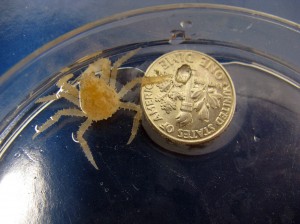King crab research program nets $460,000
December 2, 2010

907-474-7449
12/2/10
Biologists developing the science and technology to raise wild king crab in hatcheries have received $460,000 to assess how hatchery crab may fare in the wild.
Researchers at the Alaska King Crab Research, Rehabilitation and Biology program, or AKCRRAB, will use the funds to study how juvenile king crab cope with predators, find food, and interact with other marine organisms, including other crab. Their work could eventually help rebuild collapsed king crab stocks in parts of Alaska.
AKCRRAB is a coalition of university and federal scientists, fishermen, seafood businesses, coastal communities and Alaska Native groups that formed in 2006 to find ways to help Kodiak Island red king crab and blue king crab in the Pribilof Islands recover.
AKCRRAB scientists working at the Alutiiq Pride Shellfish Hatchery in Seward have steadily improved red king crab larval survival in the hatchery: from two percent in 2007 to 31 percent in 2008 to 50 percent in 2009 and 2010. During the past two years, scientists have raised about 100,000 red king crab to their first juvenile stage.
Ginny Eckert, associate professor of fisheries at the University of Alaska Fairbanks School of Fisheries and Ocean Sciences, and Allan Stoner, research fisheries biologist with the federal Alaska Fisheries Science Center in Newport, Ore., received a two-year, $303,000 grant from the NOAA Sea Grant Aquaculture Research Program. Additional in-kind and support services totaling nearly $157,000 comes from the Alutiiq Pride Shellfish Hatchery, the Alaska Department of Fish and Game, UAF and Alaska Sea Grant.
Eckert says the research is critical to evaluating the feasibility of rebuilding king crab stocks in waters around Kodiak Island and the Pribilof Islands. To better understand whether hatcheries can work, scientists need to know how their crabs would handle the rigors of life in the open ocean.
“Hatchery-cultured red king crabs have no experience with seasonal cycles, predator avoidance techniques or foraging for natural food items,” Eckert explained.
Eckert said that hatchery programs for other crab species elsewhere in the world found that hatchery crabs benefited from non-lethal exposure to predators in the hatchery.
Part of this new research will explore whether conditioning juvenile crab to predators improves survival, Eckert said.
Over the next two years, Eckert, Stoner and Ben Daly, Alaska Sea Grant research biologist assigned to the AKCRRAB program, will conduct experiments aimed at better understanding the role of habitat, crab body size, prey and predator density, water conditions and predator types, on the survival of juvenile crab. Lab experiments will be done at the Hatfield Marine Science Center in Newport. Field experiments will be conducted in Yankee Cove, near Juneau.
Raising and then releasing large numbers of hatchery-born king crab into the wild is not currently part of the AKCRRAB program. Rather, the program seeks to determine the feasibility of hatcheries as a tool to rebuild wild crab stocks. Should hatcheries be a feasible rebuilding tool, resource managers and policymakers would have to decide whether to use them.
ADDITIONAL CONTACTS: Ginny Eckert, associate professor, UAF School of Fisheries and Ocean Sciences, 907-796-5450, gleckert@alaska.edu.
ON THE WEB:www.alaskaseagrant.org
NOTE TO EDITORS: Photos are also available for download online at http://seagrant.uaf.edu/research/projects/initiatives/king_crab/photo_gallery/.
DS/12-2-10/106-11


